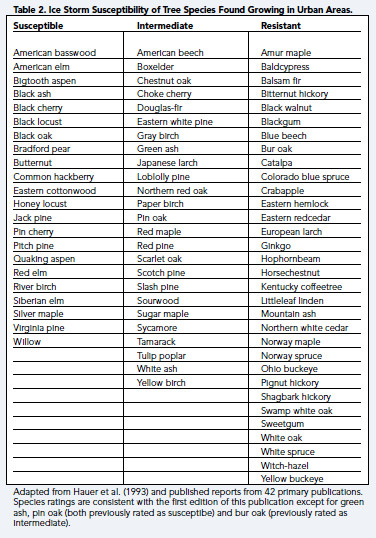4–6 minute read
damage susceptibility
Trees and evergreen shrubs are highly susceptible to storm damage. Choosing appropriate species and caring for plants properly can eliminate damage potential in most situations. Try to avoid a combination of adverse conditions. For instance, trees that fall often meet all of these criteria: shallow-rooted, heavy or unbalanced crown, and sited where soil was saturated.
Site factors
Oxygen
Most site problems are due to lack of oxygen for tree roots. When planting a tree, choose one that is naturally adapted to your site conditions.
Soil grade
Changes in soil grade also are frequent causes of tree failure. Even a few inches of fill or soil removal can cause extensive root damage. If possible, never remove or add large amounts of soil within the drip line of a tree. The table below lists species with known sensitivity/resistance to changes in soil grade:
| Sensitive | Resistant |
|---|---|
| beech dogwood most oaks pine sugar maple spruce tulip poplar | elm locust pin oak sycamore willow |
When soil air is decreased by filling, certain gases and chemicals increase and become toxic to roots. Symptoms may appear within months or years after filling has occurred.
- The extent of injury from filling varies with the species, age, and condition of the tree; the depth and type of fill; and drainage.
- Clay soils cause the most damage because the fineness of the soil shuts out air and water more than a gravelly or coarse soil.
- Three to four inches of soil can be added to small areas under the tree provided the soil texture is coarser than the native soil. Finer textured soils should not be used for filling.
Plant factors
Form
Good form is important at several levels:
Good branch angle is critical. A right angle from the trunk is the strongest. Crotches become progressively weaker as the angle decreases. A crotch angle should always be at least 45°. Poor crotch angles result in included bark in the crotch, which ultimately leads to splitting (the Bradford pear is notorious in this respect).
Branch organization is equally important. The tree should have a single leader and widely-spaced branches both vertically and radially. Pruning to reduce branch density can be beneficial for species like crabapples and crape myrtle. The form should be triangular with most weight at the bottom of the tree. Trees with poor form are highly susceptible to storm damage.
| Poor form |
|---|
| european mountain ash green ash amur cherry hackberry littleleaf linden maples --- box elder, red, silver Bradford pear willows |
Because damaging ice storms are frequent in Orange County, they should be considered a limiting factor for plants that will perform well here. Plant selection should give preference to shrubs and trees, especially large trees, with crowns resistant to breakage.
 IL Extension Trees and ice storms
IL Extension Trees and ice storms
Decay
For every 3 inches of branch or stem diameter, solid wood should comprise at least 1–1.5 inches. A branch or stem with less is more likely to fail during a storm.
| Decay problems common |
|---|
| Aspen Birch --- gray Hackberry Lindens --- basswood, littleleaf Oaks --- Northern pin, red, black Maples --- box elder, red, silver Willows |
Girdling roots
Stem-girdling roots lie at or below the soil surface and partially or completely encircle the trunk of the tree. They eventually compress the lower trunk, creating a weak point that is often the point of failure in high winds. Many stem-girdling root problems are due to poor planting:
- planting pot-bound trees without first pruning off the girdling root (no matter how large) or spreading roots out if they are still flexible
- planting too deep rather than with the first branch roots just below the soil surface
- failing to remove synthetic burlap from a root ball. Synthetic burlap does not decay and roots will never penetrate into the native soil.
Trees that are native to floodplain areas (elms, maples, etc.) have the tendency to form ‘stem’ roots in sites where they are frequently buried by floodplain material. These trees commonly form encircling roots when planted in the urban environment, particularly when they are planted too deep. The species below are the most likely to develop stem girdling roots in urban situations.
| Girdling roots likely |
|---|
| green ash littleleaf linden maples --- Norway, red, silver poplars |
height & moisture content
Tall trees are the most vulnerable to lightning, especially those growing alone in open areas or near water. Moisture content is also a significant factor. Consequently, some species are struck more frequently than others. Note that while conifers are less likely to be struck than hardwoods of the same size, conifers will sustain more damage.
Likelihood of lightning strike
| Low | Medium | High | Very High |
|---|---|---|---|
| beech birch | elm maple pine spruce | ash oak | tulip poplar |
See Lightning for more information.
Storm damage
For information on how to reduce, monitor and address storm damage, see:
